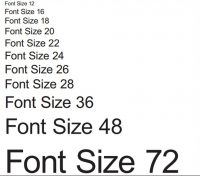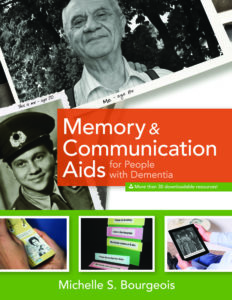
Memory and Communication Aids for People with Dementia, by Dr. Michelle Bourgeois, is a practical guide of communication and memory aids to significantly improve the ability of people with dementia and related memory impairments to stay connected, engaged, and functioning at their optimal level of independence.
Here, Dr. Bourgeois answers questions from a reader of her book about specific incidents in his skilled nursing facility, and how best to use the aids to solve problems.
This content covers the Reading Assessment Tool as well as using memory aids to meet unmet needs. All images are excerpted from Memory and Communication Aids for People with Dementia, by Michelle Bourgeois, Ph.D., CCC-SLP. Copyright © 2014 by Health Professions Press, Inc. All rights reserved.
Question:
Dr. Bourgeois,
I purchased your book on making memory books and am putting it to use! I really appreciate all that you did to put that book together.

I used your Reading Assessment Tool and wanted to make sure that I did it correctly: I copied your pictures with their “subtitles” in two sizes, in case print size might be an issue. The lady I showed them to had verbal responses and behavioral responses!
At first sight she was a little guarded—she is one that will turn away quickly—but by calling her name she comes right back to you. The second time through, she read words, phrases and a complete sentence. I had a family member take home one of your handouts to try and gather info and hopefully some pictures to create a memory book.
I am excited to explore this very important skill of many persons with dementia and see if I can use written word and images to help with behavioral changes as well as provide meaningful interaction with family and staff.
Answer:
Jeff,
Thanks for writing. I’m glad you’re finding memory books useful! And I’m happy to answer questions!
The purpose of the Reading Assessment (2 sizes) is to see which font size elicits the most accurate/fluent/easy reading…so that you know what size font is best for whatever text materials you create for the person. I also use the Reading Assessment to determine comprehension by noting what the person might say in response to the picture/caption. For example, after reading, “The dog’s name is Rover,” the person might say, “I don’t think I ever had a dog named Rover, mine was Buster.” That tells you that they understood what they read and can relate it to information in their long term memory —both evidence of expectation that visual cues in the form of pictures and captions will be effective for the person.

If your person was having trouble reading the large print version —only reading single words, or a couple at a time—then I would try a larger font, and short phrases instead of entire sentences for the Memory Book. In the later stages of dementia, reading of personal information (e.g., family member names, familiar phrases) is possible and will trigger related memories in the form of words, or even meaningful vocalizations (pleasant humming).
Question:
I have one patient who is very upset inside. He refers to the staff as “kids,” so I can tell he has some sense of being an Elder but the “kids” are trying to force him to do things. It’s a control issue. However, it is hurting his chances at staying in the [skilled nursing facility]. He is refusing all medications, fights blood sugar testing and insulin injections, fights all patient care including showers and such. I typed up an orientation sheet with five sentences that he could read to me regarding where, why, and such for SNF and his need to get stronger.
Not sure what to do.
Thanks for your insight.
Answer:
Try developing his own personal daily schedule WITH him….so he feels in control of what he does and doesn’t do each day. Agree with him that he doesn’t need “kids” telling him what to do, if he has his own schedule to follow and to show them. While developing it, you can discuss why his blood needs to be tested, why he needs a shower, etc. And ask him when he wants to do it; give him options: 9 am or 9:15? Does he want his shower in the morning or in the evening? Make up the schedule in such

a way that he feels he’s in control. But with your knowledge of what the staff can realistically do, you will have to suggest times for him to pick from that you know would be okay with the staff. THEN discuss with staff the necessity of following his schedule. He could even cross off each activity if you make an extra column for that purpose.
There are examples of checklists in the book—you’ll just need to list the times and activities that you’ve agreed upon with him. I’d also suggest you make the schedule portable so that he can have it with him if he’s walking around the facility. Does he wear shirts with a front pocket? Then make the schedule 3 x 5 inches so he can easily carry it around with him. Maybe a lanyard around his neck would work. But ask him to help you select it or figure out how to keep his schedule handy to show to those pesky kids!
Best wishes….and write back to let me know how it goes and if these ideas work. We can always problem solve some more.
Read the book!
Memory and Communication Aids for People with Dementia
By Michelle S. Bourgeois, Ph.D., CCC-SLP
Copyright © 2014 by Health Professions Press, Inc.
With full-color illustrations and simple instructions for creating various memory and communication tools, these evidence-based examples help to provide conversation prompts, answers to common questions, and reminders for daily living. Filled with useful content and formats and more than 30 downloadable guides and templates to use or customize, this book also provides information to develop personalized supports for any individual and any circumstance.



I am new to using memory aids for my patients with cognitive dysfunction. What book do you recommend for working with older psych patients I see at home?
Thanks,
Gary S. Sorock, RN., MS